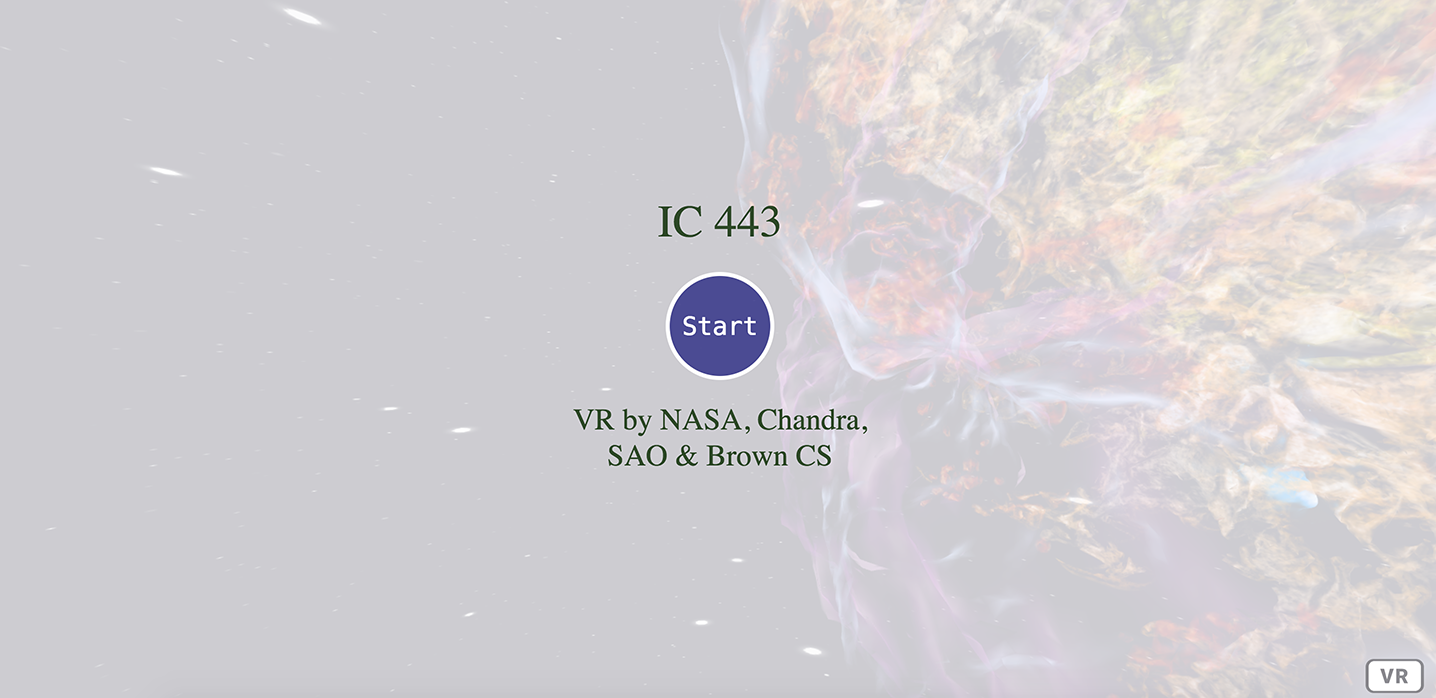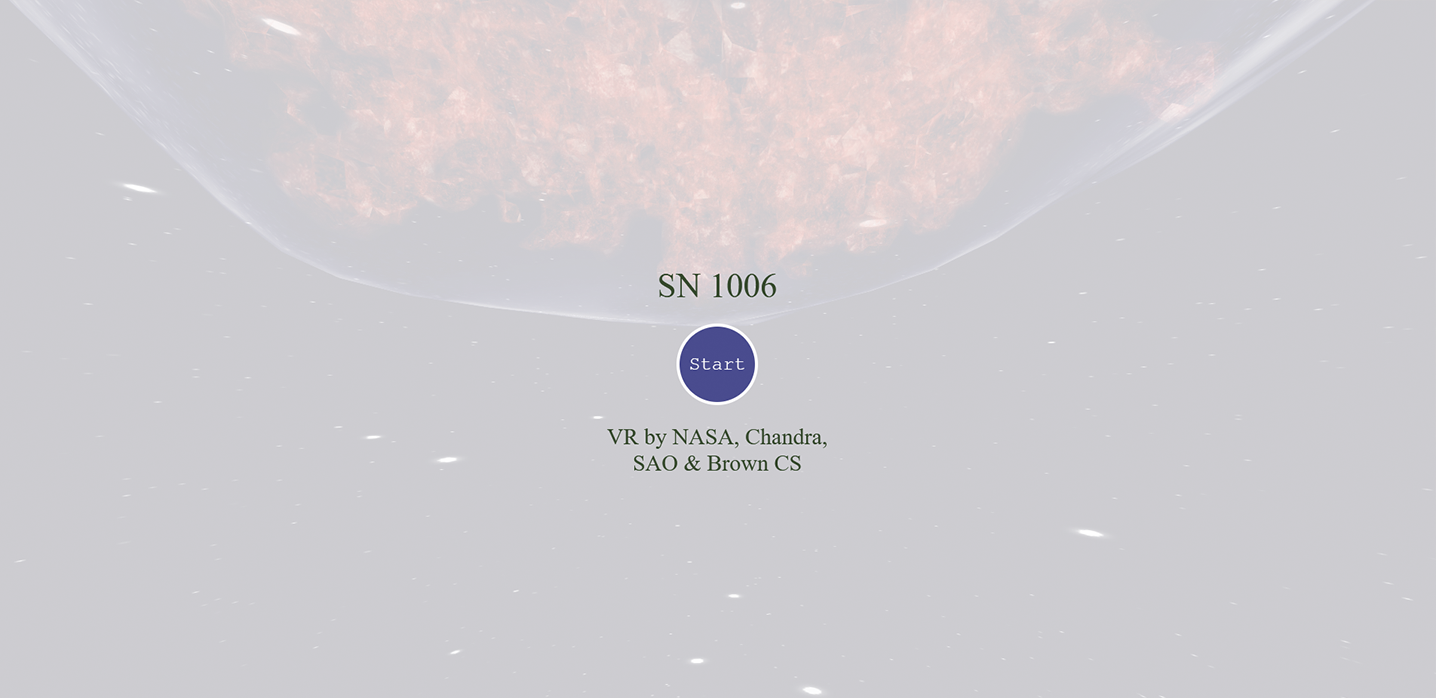

Virtual Reality Projects
SN1006
This 3D model shows the SN1006 supernova remnant that resulted from the powerful explosion and complete destruction of a white dwarf star. The model helps explore how the clumping of material after the explosion and the acceleration of high-energy particles affects the structure of the remnant. A ball of fiery-looking stellar debris and heavy elements has been shot into the interstellar medium with speeds of tens of thousands of miles per hour. The material is heated up to temperatures of tens of millions of degrees that Chandra observes in X-ray light.
Credit:
The 3D model is part of the collection “Universe in Hands” by S. Orlando, INAF-Osservatorio Astronomico di Palermo. The VR application was adapted under the direction of Kimberly Arcand of CXC/SAO by Tom Sgouros along with Alexander Dupuis of Brown University.
Format:
Phone-friendly version at:
https://chandra.harvard.edu/vr/sn1006/
IC 443
A Chandra 3D model in VR is available of the stunning supernova remnant (remains of an exploded star) called IC 443, located about 5,000 light years from Earth. Scientific details of the model were included in a paper published in the journal Astronomy & Astrophysics led by Sabina Ustamujic from the National Institute for Astrophysics (INAF) in Palermo, Italy.
The 3D model gives important information about the supernova explosion that formed IC 443. It shows that the explosion was weaker than most supernovae and that it occurred about 8,000 years ago, in Earth's time frame. In addition, this work provides new evidence that a source of X-rays discovered with Chandra contains the neutron star that formed when a massive star collapsed and exploded to create IC 443.
An adaptation of the scientific 3D model was optimized for virtual reality (VR). In this 3D version of IC 443, the outer blast wave of the explosion is blue, while the outer layers of the star are in reds and oranges. Chandra's data of the nebula of particles and energy around the neutron star is found at the center of this VR version (cyan).
 Credit:
Credit:The VR application was created under the direction of Kimberly Arcand of CXC/SAO and Tom Sgouros of Brown University by Alexander Dupuis of Brown University. IC443 Simulation: INAF/S. Ustamujic et al.; X-ray data: NASA/CXC/MSFC/D.Swartz et al.; VR model: NASA/CXC/Brown Univ./A.Dupuis et al.
Format:
Phone-friendly version at: https://chandra.harvard.edu/vr/ic443/
Supernova 1987A
Supernova 1987A (SN 1987A) was first seen in the Large Magellanic Cloud by observers in the southern hemisphere on February 24, 1987. It was the nearest supernova explosion seen in modern times and provides astronomers the best opportunity ever to study the phases before, during, and after the death of a star.
The latest data from these powerful telescopes indicate that SN 1987A has passed an important threshold. The supernova shock wave is moving beyond the dense ring of gas produced late in the life of the pre-supernova star when a fast outflow or wind from the star collided with a slower wind generated in an earlier red giant phase of the star's evolution. What lies beyond the ring is poorly known at present, and depends on the details of the evolution of the star when it was a red giant.
Chandra began observing SN 1987A shortly after its deployment in 1999. From 1999 until 2013, Chandra data showed an expanding ring of X-ray emission that had been steadily getting brighter. The blast wave from the original explosion has been bursting through and heating the ring of gas surrounding the supernova, producing X-ray emission.
In the past few years, there have been striking changes in the Chandra data. From about February 2013 until the last Chandra observation analyzed in September 2015 the total amount of low energy X-rays has remained constant. Also, the bottom left part of the ring has started to fade. These changes provide evidence that the explosion's blast wave has moved beyond the ring into a region with less dense gas. This represents the end of an era for SN 1987A.
This first three-dimensional model and animation of SN 1987A that links the supernova to its remnant was made possible by modeling and simulations constrained by the Chandra X-ray observations. More information is at SN87a
The 3D model was done by Salvatore Orlando of INAF in Palermo, Italy, and his colleagues. The simple VR application of SN 1987A was adapted under the direction of Kimberly Arcand of CXC/SAO with Tom Sgouros and Alexander Stewart of Brown University.
Format:
Oculus Go available upon request. Phone-friendly version in progress.
Chandra Spacecraft
Since its launch and deployment from Space Shuttle Columbia on July 23, 1999, the Chandra X- ray Observatory has been NASA's flagship mission for X-ray astronomy. In honor of Chandra’s 20 th year of operations in space, a VR application was developed that provided a brief tour of the Chandra observatory and its main parts.
NASA's Chandra X-ray Observatory is a telescope specially designed to detect X-ray emission from very hot regions of the Universe such as exploded stars, clusters of galaxies, and matter around black holes. Because X-rays are absorbed by Earth's atmosphere, Chandra must orbit above it, up to an altitude of 139,000 km (86,500 mi) in space.
Chandra carries four very sensitive mirrors nested inside each other. The energetic X-rays strike the insides of the hollow shells and are focused onto electronic detectors at the end of the 9.2- m (30-ft.) optical bench.
For more information on the Chandra spacecraft and its components, you can also visit the non- VR interactive piece: https://chandra.si.edu/about/hardware.html
The VR application was created under the direction of Kimberly Arcand of CXC/SAO by Tom Sgouros, Alexander Stewart, and Elaine Jiang of Brown University.
Format:
Oculus Go and Quest available upon request. Phone-friendly version at: https://chandra.harvard.edu/vr/chandra_vr/
Crab Nebula
The Crab Nebula shows the remains of an exploded star located about 6,500 light years from Earth. The powerhouse “engine” energizing the Crab system is a pulsar, a rapidly spinning neutron star, shooting out pulses of radiation 30 times a second. X-ray information from NASA’s Chandra X-ray Observatory was used to create a three-dimensional representation of the Crab. The X-ray structure shows the pulsar and a ringed disk of energized material, with jets of particles that fire off from opposite ends of the energetic pulsar.
Credits:
Frank Summers and the STScI visualization team, with Robert Hurt & Nancy Wolk, worked on the data. NASA's Universe of Learning materials are based upon work supported by NASA under cooperative agreement award number NNX16AC65A to the Space Telescope Science Institute, working in partnership with Caltech/IPAC, Jet Propulsion Laboratory & CfA. This VR application was adapted under the direction of Dr. Kimberly Arcand of CXC/SAO and Tom Sgouros by Alex Stuart and Alex Dupuis of Brown University.
Format:
Phone-friendly version at:
https://chandra.harvard.edu/vr/crab/
U Scorpii
A nova is a star that suddenly increases its light by tens or hundreds of times and then fades away to its former brightness in a just few months. In these nova systems, a white dwarf star — a compact star that has evolved from a sun-like star following a red giant phase — pulls material from a nearby companion star until enough accumulates to trigger a thermonuclear explosion on the star’s surface. The 3D simulation explores the first 18 hours after the last outburst observed on January 28, 2010 in U Scorpii. Astronomers have seen U Scorpii erupt about once every decade, so this system is due for another outburst very soon.
Credits:
The science results were reported by Jeremy Drake of Center for Astrophysics | Harvard
& Smithsonian and colleagues. The 3D model is part of the collection “Universe in Hands”
by Sal Orlando, INAF-Osservatorio Astronomico di Palermo (https://skfb.ly/6NooE). This
VR application was adapted under the direction of Kimberly Arcand of CXC/SAO by Tom
Sgouros of Brown University.
Format:
Phone-friendly version at:
https://chandra.harvard.edu/vr/scorpii
Tycho
This 3D model is a representation of Tycho’s supernova remnant. Like SN 1006, Tycho has resulted from the explosion of a white dwarf star. The model shows how Tycho’s supernova remnant might appear at an age of a thousand years, after evolving from its current age of 447 years. Sky watchers from Earth recorded the original supernova explosion in the year 1572 AD. The stellar debris contains a cutout section to show the interior of the remnant.
Credit:
The 3D model is part of the collection “Universe in Hands” by S. Orlando, INAF-Osservatorio
Astronomico di Palermo. This VR application was adapted under the direction of Kimberly Arcand of CXC/SAO by Tom Sgouros along with Alexander Dupuis of Brown University.
Format:
Phone-friendly version at:
https://chandra.harvard.edu/vr/tycho
Galactic Center
"Galactic Center VR" (GCVR) transports you 26,000 light years away to the center of our Milky Way. This fully immersive VR experience lets you explore our NASA supercomputer simulations of the central three light years around Sagittarius A* (Sgr A*), our galaxy's supermassive black hole. While the black hole is the region's dominant feature, the visual appeal comes from the complex structure of colliding winds from 25 massive stars, much of which is heated by shocks — akin to sonic booms from supersonic aircraft — to be aglow in X-rays and therefore studied with NASA's Chandra X-ray Observatory.
June 2020 update:
By combining data from telescopes with supercomputer simulations and virtual reality, a new version of this visualization allows you to experience 500 years of cosmic evolution around the supermassive black hole at the center of the Milky Way.
This visualization, called "Galactic Center VR", is the latest in the series, and is based on data from NASA's Chandra X-ray Observatory and other telescopes. This installment features their NASA supercomputer simulations of material streaming toward the Milky Way's four-million-solar-mass black hole known as Sagittarius A* (Sgr A*). The visualization has been loaded into a VR environment as a novel method of exploring these simulations, and is available for free at both the Steam and Viveport VR stores.
Credit:
The research was led by Christopher Russell of the Pontificia Universidad Católica de Chile (Pontifical Catholic University of Chile).
Format:
"Galactic Center VR" is available on Steam and Viveport for the HTC Vive, though we plan to develop versions for other VR headsets in the future. Also, see our 360-degree page for more formats, including YouTube, as well as our blog post describing the creation of the VR app.
